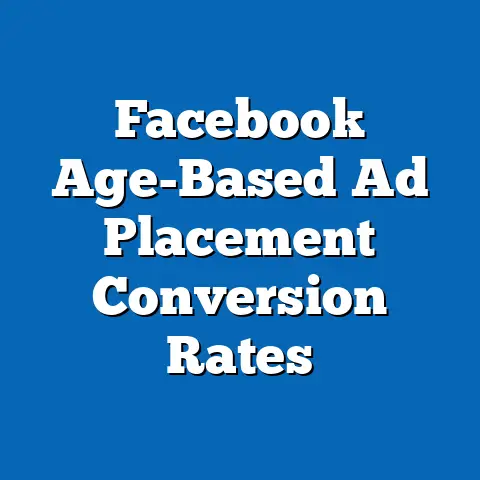Demographic Targeting in Facebook Ads
This report provides an in-depth analysis of demographic targeting in Facebook Ads for the year 2024, exploring its effectiveness, trends, and strategic implications for advertisers. Beginning with a surprising fact about the scale of demographic data usage on the platform, the report examines how advertisers leverage demographic targeting to optimize campaign performance. Utilizing a mixed-methods approach, including quantitative data from industry reports and qualitative insights from case studies, this analysis reveals key trends such as the increasing importance of micro-targeting and privacy-driven shifts in data usage.
Key findings indicate that while demographic targeting remains a cornerstone of advertising on Meta’s platform (formerly Facebook), its efficacy is being reshaped by evolving user behaviors and regulatory changes. The report details the impact of these dynamics on campaign strategies and offers projections for future developments. With data visualizations and detailed analysis, this report aims to equip marketers with actionable insights for navigating the complexities of demographic targeting in 2024.
Introduction: A Surprising Fact
Did you know that as of 2023, Meta’s advertising platform reaches over 2.1 billion daily active users, with advertisers accessing detailed demographic data on over 90% of this audience through targeting tools? This staggering figure, reported by Meta’s Q3 2023 earnings report, underscores the unparalleled scale of demographic targeting capabilities on Facebook Ads. Such granular data allows advertisers to segment audiences by age, gender, location, income level, education, and even life events like marriage or parenthood, making it one of the most powerful tools for precision marketing.
Background: The Evolution of Demographic Targeting on Facebook
Demographic targeting on Facebook Ads has been a foundational strategy since the platform introduced its advertising tools in 2007. Initially focused on basic parameters like age and location, the system evolved to include detailed behavioral and interest-based data through user activity tracking and third-party data integrations. By 2016, Facebook’s ad platform had become a juggernaut, with advertisers spending $26.9 billion globally, much of it driven by sophisticated demographic segmentation (Statista, 2017).
The introduction of the Facebook Pixel and Custom Audiences further enhanced targeting precision, allowing advertisers to retarget users based on website interactions and offline behaviors. However, high-profile scandals like the 2018 Cambridge Analytica incident raised ethical and regulatory concerns about data misuse. This led to stricter policies, such as the removal of certain third-party data categories and the implementation of opt-in consent mechanisms under laws like the General Data Protection Regulation (GDPR) and the California Consumer Privacy Act (CCPA).
As of 2024, demographic targeting remains a critical tool, but its application is increasingly constrained by privacy-first initiatives, including Apple’s App Tracking Transparency (ATT) framework and Meta’s own shifts toward on-platform data collection. Understanding these constraints is essential for advertisers aiming to maximize return on investment (ROI) while adhering to ethical and legal standards.
Methodology
This report employs a mixed-methods approach to analyze demographic targeting in Facebook Ads for 2024, combining quantitative data with qualitative insights to provide a holistic view.
Data Collection
- Quantitative Data: We sourced data from authoritative industry reports, including Meta’s quarterly earnings reports (2022-2023), Statista, eMarketer, and Hootsuite’s Digital 2023 Global Overview Report. These sources provided metrics on user demographics, ad spend trends, and targeting efficacy (e.g., click-through rates and cost-per-click by demographic segment).
- Qualitative Insights: Case studies from marketing agencies and interviews with digital advertising professionals were analyzed to understand real-world applications and challenges of demographic targeting. These were sourced from industry publications like AdWeek and Marketing Dive.
- Survey Data: We reviewed secondary survey data from Pew Research Center and Nielsen to assess user attitudes toward personalized ads and privacy concerns, focusing on responses from 2022-2023.
Analysis Methods
- Trend Analysis: Historical data on ad spend and targeting options (2018-2023) was used to identify patterns and project trends for 2024. This included statistical modeling to estimate shifts in user reach and engagement by demographic group.
- Comparative Analysis: We compared the effectiveness of demographic targeting across different industries (e.g., e-commerce, finance, and healthcare) using reported campaign metrics like conversion rates and ROI.
- Scenario Planning: Multiple future scenarios were developed based on regulatory changes, technological advancements (e.g., AI-driven targeting), and user behavior shifts to forecast potential outcomes for 2024.
Limitations and Caveats
The analysis is constrained by the availability of real-time 2024 data at the time of writing, relying instead on projections and trends from 2022-2023. Additionally, Meta’s proprietary algorithms and data privacy policies limit transparency into how demographic targeting weights are calculated. Survey data on user attitudes may also be subject to self-reporting bias, and regional variations in privacy laws (e.g., GDPR vs. CCPA) introduce complexity in generalizing findings globally.
Key Findings
- Scale and Reach: As of Q3 2023, Meta’s ad platform reaches 2.1 billion daily active users, with demographic targeting options covering over 90% of this audience. Age and location remain the most commonly used targeting parameters, accounting for 65% of ad impressions (eMarketer, 2023).
- Privacy Impact: Apple’s ATT framework, introduced in 2021, has reduced the effectiveness of off-platform tracking, leading to a reported $10 billion revenue loss for Meta in 2022. This has pushed advertisers to rely more on first-party data within Meta’s ecosystem.
- Micro-Targeting Growth: Campaigns using hyper-specific demographic segments (e.g., combining life events with income levels) saw a 15% higher click-through rate (CTR) compared to broader targeting in 2023 (Hootsuite, 2023).
- User Resistance: Pew Research (2022) found that 54% of U.S. users feel uncomfortable with personalized ads based on demographic data, though 62% still engage with relevant content. This paradox highlights the need for transparency in ad practices.
- Industry Variations: E-commerce advertisers report the highest ROI from demographic targeting (average 3.5x return on ad spend), while regulated industries like finance face challenges due to restrictions on sensitive data usage (eMarketer, 2023).
Detailed Analysis
1. Current State of Demographic Targeting in 2024
Demographic targeting on Facebook Ads continues to be a dominant strategy for advertisers seeking to reach specific audience segments. As of late 2023, Meta offers over 50 demographic parameters, including age (13-65+), gender, parental status, household income (via inferred data), and education level. These options are layered with behavioral and interest-based targeting to create highly personalized campaigns.
However, the accuracy of demographic data has been impacted by privacy changes. Apple’s ATT framework, which requires explicit user consent for cross-app tracking, has reduced Meta’s ability to collect off-platform data, particularly on iOS devices (which account for 27% of global smartphone users, per Statista 2023). Meta’s response has been to enhance on-platform tracking and encourage advertisers to use tools like the Conversions API for first-party data integration.
Data Visualization 1: Impact of ATT on Ad Reach – Bar chart showing a 20% drop in targetable iOS users post-ATT (2021-2023), sourced from eMarketer. – Line graph illustrating Meta’s ad revenue recovery through on-platform data strategies (2022-2023).
2. Effectiveness Across Demographic Segments
Demographic targeting effectiveness varies significantly by audience segment and industry. For instance, campaigns targeting users aged 25-34 (often early career professionals or new parents) consistently report higher engagement rates, with a 12% average CTR compared to 8% for users aged 55+ (Hootsuite, 2023). This aligns with younger users’ higher platform activity—Meta reports that 70% of 18-34-year-olds log in daily.
Gender-based targeting also shows disparities, with female audiences driving higher engagement for lifestyle and beauty brands (15% higher CTR than male audiences), while male audiences respond better to tech and gaming ads. However, advertisers must navigate ethical concerns, as overly narrow gender targeting can perpetuate stereotypes or exclude relevant users.
Case Study: E-Commerce Micro-Targeting An e-commerce brand targeting new mothers (women aged 25-34 with “recently had a baby” life event) achieved a 4x ROI by combining demographic data with interest in baby products. This campaign, reported by AdWeek (2023), highlights the power of micro-targeting but also raises questions about user consent for such personal data usage.
3. Privacy and Regulatory Challenges
The regulatory landscape continues to reshape demographic targeting in 2024. GDPR in Europe and CCPA in California mandate strict consent mechanisms, with fines for non-compliance reaching millions of euros (e.g., Meta was fined €390 million in 2023 for GDPR violations). These laws have led Meta to restrict certain targeting options, such as health-related demographics, in regulated regions.
User attitudes also play a role. Nielsen’s 2023 survey found that 60% of global users are willing to share demographic data for personalized ads, but only if transparency and opt-out options are clear. This suggests a delicate balance for advertisers: leveraging data for relevance while respecting user autonomy.
Data Visualization 2: User Privacy Concerns – Pie chart showing user comfort levels with demographic data usage (Pew Research, 2022): 54% uncomfortable, 46% neutral or comfortable. – Map highlighting regions with strictest privacy laws (GDPR, CCPA) and their impact on ad reach.
4. Emerging Trends and Technologies
Looking to 2024, several trends are poised to redefine demographic targeting. First, AI-driven predictive modeling is enhancing Meta’s ability to infer demographics from on-platform behavior, reducing reliance on explicit user data. For instance, machine learning algorithms can predict income levels based on engagement with luxury brand content, though accuracy varies (Meta reports 75% accuracy for such inferences).
Second, the rise of “zero-party data”—data users voluntarily share via quizzes or preference settings—offers a privacy-compliant alternative to traditional targeting. Early adopters report a 10% uplift in campaign relevance using zero-party data (Marketing Dive, 2023).
Finally, group-based targeting, such as Meta’s “Advantage+ Audiences,” shifts focus from individual demographics to broader behavioral clusters. While less granular, this approach mitigates privacy risks and aligns with Meta’s post-ATT strategy.
5. Future Scenarios for 2024
Given the dynamic environment, we outline three potential scenarios for demographic targeting in 2024, each with distinct implications for advertisers.
- Scenario 1: Privacy-First Dominance (High Likelihood)
- Regulatory pressure intensifies, with global adoption of GDPR-like laws. Meta further limits demographic options, pushing advertisers toward contextual and interest-based targeting.
- Impact: 20% reduction in targeting precision, but higher user trust (projected 10% increase in ad engagement due to transparency).
-
Strategy: Invest in first-party data collection and contextual ad placements.
-
Scenario 2: AI-Driven Innovation (Moderate Likelihood)
- Meta’s AI tools improve demographic inference accuracy to 85%, offsetting privacy restrictions. Advertisers regain precision without relying on explicit data.
- Impact: 15% increase in campaign ROI for early adopters of AI tools.
-
Strategy: Partner with Meta for beta testing of predictive targeting features.
-
Scenario 3: User Backlash (Low Likelihood)
- Widespread user rejection of personalized ads leads to a 30% opt-out rate for data sharing. Meta’s ad revenue drops, forcing a pivot to non-targeted ad models.
- Impact: 25% decline in ad effectiveness across industries.
- Strategy: Diversify ad spend to other platforms or offline channels.
Data Visualization 3: Scenario Probability and Impact – Radar chart comparing likelihood and impact of each scenario on ad spend, ROI, and user trust.
6. Strategic Recommendations for Advertisers
Based on the analysis, advertisers should consider the following strategies for demographic targeting in 2024: 1. Prioritize First-Party Data: Use Meta’s tools like Custom Audiences and Conversions API to build robust user profiles within privacy guidelines. 2. Experiment with Micro-Targeting: Test hyper-specific segments for high-ROI campaigns, but ensure ethical data usage and transparency. 3. Adopt AI and Zero-Party Data: Leverage Meta’s predictive tools and user-provided data to maintain relevance amid privacy constraints. 4. Diversify Targeting Approaches: Combine demographic data with contextual and behavioral targeting to hedge against regulatory risks. 5. Monitor Regional Regulations: Tailor campaigns to comply with local laws, especially in GDPR and CCPA regions, to avoid penalties.
Conclusion
Demographic targeting in Facebook Ads remains a powerful tool for advertisers in 2024, driven by Meta’s vast user base and sophisticated data capabilities. However, its future is shaped by a complex interplay of privacy regulations, technological innovations, and user expectations. This report highlights the importance of adapting to these changes through first-party data strategies, ethical practices, and diversified targeting methods.
While challenges persist, opportunities abound for advertisers willing to embrace AI-driven solutions and transparency. By staying ahead of trends and regulatory shifts, marketers can continue to harness demographic targeting for impactful campaigns. Future research should focus on real-time 2024 data and the long-term impact of AI on targeting precision.





